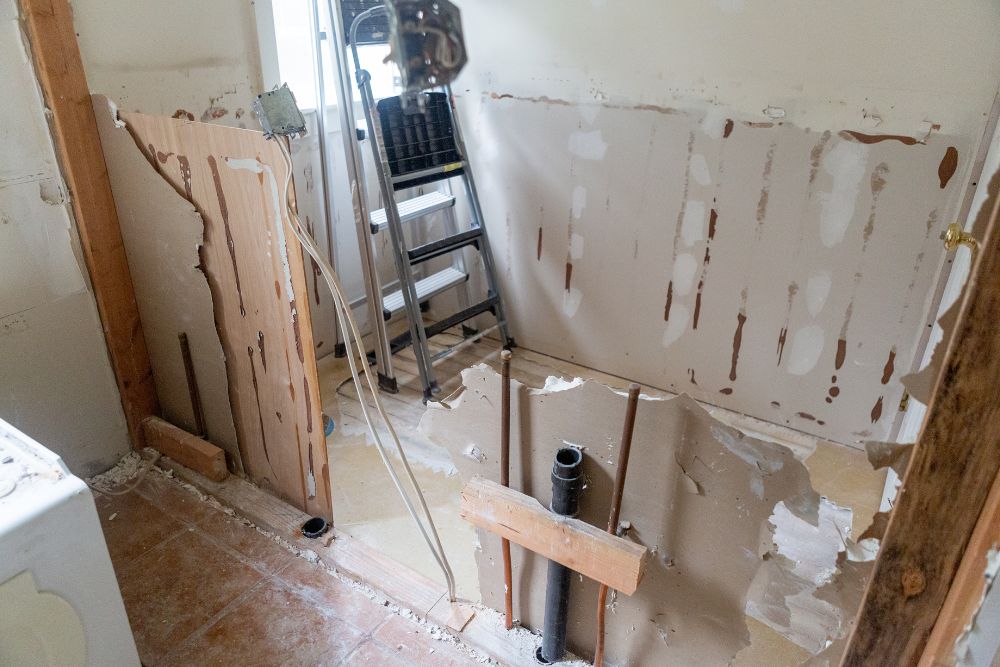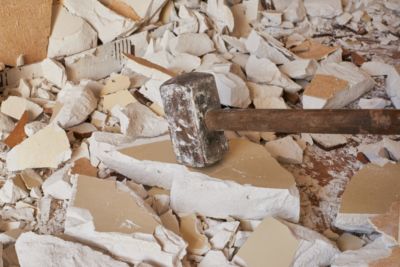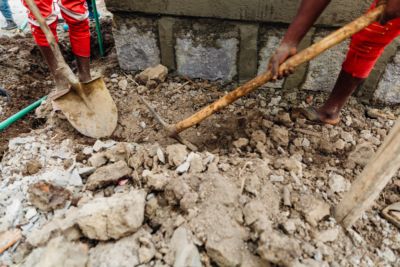
How to Safely Deal with Concrete Debris After Removal
September 9, 2025
Drywall Removal How to Prepare Your Home
September 9, 2025Tips for Efficient Kitchen Demolition Cleanup
A kitchen demolition is often the first step toward a fresh, modernized space, but with it comes a mountain of debris, dust, and clutter. Cabinets, countertops, tiles, and drywall can quickly turn into a chaotic mess if not handled properly. What should be an exciting beginning can feel overwhelming without the right plan for cleanup. To keep the process manageable, preparation and organization are key.
Efficient cleanup ensures that your renovation project stays on schedule and that your home remains safe during the transition. From removing bulky items to sorting recyclable materials, every step matters. With smart strategies, a messy kitchen demolition transforms into an organized process that leaves your space ready for its next stage of construction. By focusing on order and safety, you save time, reduce stress, and minimize potential hazards. A clear plan ensures the demolition doesn’t overshadow the excitement of your kitchen’s transformation.
Preparing your space before demolition begins
Getting ahead of the mess starts before the first hammer swing. Removing personal belongings, appliances, and cookware prevents them from being damaged or covered in dust. Clearing countertops and emptying cabinets ensures that no items are accidentally broken or lost in the debris. This step also creates more space for moving out large materials once demolition is underway.
Taking precautions like sealing doorways with plastic sheeting and covering floors with protective materials can prevent dust and sharp fragments from spreading to other parts of your home. The better your preparation, the smoother the cleanup becomes afterward. Instead of scrambling to protect surfaces mid-demolition, you’ll know the essentials are safe. Thoughtful preparation not only protects your property but also creates a safer, more organized environment for everyone involved in the project.

Removing large fixtures in stages
One of the most effective ways to control demolition waste is removing large fixtures in manageable stages. Cabinets, countertops, and appliances should be taken out before smaller items are addressed. Tackling one type of fixture at a time keeps the debris organized, which makes cleanup easier and safer. Large materials often create sharp edges or bulky piles, so removing them in order ensures they don’t interfere with handling smaller debris.
Breaking down large fixtures carefully also reduces the risk of injury. For example, detaching cabinets rather than smashing them allows you to stack or transport pieces neatly. Countertops can be cut into sections rather than hauled away in one heavy slab. By treating the removal as a step-by-step process, you minimize chaos while giving yourself a clearer plan for cleanup afterward. This methodical approach turns demolition into a structured task rather than a cluttered free-for-all.
Sorting materials for recycling and disposal
A kitchen demolition produces a wide variety of waste, from wood and metal to tile, drywall, and glass. Sorting these materials as you go makes disposal faster and more sustainable. Metals such as aluminum or stainless steel can often be recycled, while clean wood may be repurposed. Keeping piles organized during demolition prevents recyclable items from mixing with non-recyclable waste, saving time when it’s time for removal.
This practice also reduces disposal costs. Recycling centers may accept certain materials at lower fees than landfills, and in some cases, they might even provide credit for metals. By planning ahead and sorting effectively, you not only lessen the environmental impact but also streamline cleanup. The key lies in treating waste as resources rather than garbage, giving value to what’s left behind and preventing everything from being lumped together unnecessarily.
Containing dust and airborne particles
Demolition dust can travel farther than expected, settling on furniture, electronics, and hidden corners of your home. To keep the mess under control, plastic sheeting should be used to seal off rooms, and vents should be covered to prevent dust from circulating through your HVAC system. Working with fans and air purifiers can also reduce airborne particles during the process.
Sweeping up dust periodically rather than waiting until the end keeps it from accumulating into an overwhelming problem. Masks are essential during demolition, as dust from drywall and plaster can irritate the lungs. By keeping dust contained and addressing it consistently, you protect your health and reduce the time needed for post-demolition cleaning. Dust may seem harmless, but controlling it ensures that cleanup remains efficient and doesn’t stretch into days of wiping down surfaces long after the work is done.
Using proper safety gear during cleanup
Kitchen demolition cleanup is not just about removing debris—it’s about doing it safely. Gloves are essential for protecting your hands from nails, splinters, and sharp tile edges. Safety goggles prevent dust and flying fragments from causing eye injuries, while sturdy boots protect feet from falling materials. These items aren’t optional; they are fundamental to ensuring that the cleanup process doesn’t result in unnecessary accidents.
In addition to personal gear, tools such as dust masks, knee pads, and ear protection make cleanup less taxing on the body. The process often requires lifting heavy objects and bending frequently, so having the right support reduces fatigue. A safe worker is a more efficient worker, and maintaining safety protocols ensures that the cleanup is completed quickly without interruptions caused by injuries or discomfort. Protecting yourself allows you to focus on completing the task thoroughly and effectively.
Scheduling junk removal for bulky waste
A major kitchen demolition generates more debris than most homeowners can handle on their own. Scheduling junk removal ensures that large volumes of waste are taken away efficiently, freeing up space for the renovation to continue. Instead of letting bulky items clutter your yard or driveway, professional hauling removes them in one organized step.
Junk removal services also understand the correct way to dispose of materials, ensuring compliance with local disposal regulations. By relying on professionals for the heavy lifting, you save yourself from the strain of moving massive items like countertops or broken appliances. Scheduling pickups at the right time ensures that cleanup is seamless, and you won’t be stuck with piles of debris long after the demolition is over. This step prevents delays in your renovation and allows you to enjoy a cleaner, safer workspace.
Protecting surrounding rooms from debris spread
A kitchen demolition often spills beyond the boundaries of the kitchen if containment measures aren’t in place. Dust, small fragments, and even loose nails can find their way into nearby rooms, creating extra cleanup that could have been avoided. Using tarps, barriers, and sealed doorways helps confine the mess to the kitchen, where it’s easier to manage.
Furniture and floors in nearby areas should also be covered with protective sheets. Even if these rooms aren’t part of the renovation, they can still suffer damage if precautions aren’t taken. By protecting surrounding rooms, you cut down on unnecessary cleanup and ensure the rest of your home remains functional during the project. This makes the process less stressful and allows you to maintain a level of normalcy while the kitchen is being transformed.
Maintaining organization during cleanup
Staying organized throughout demolition cleanup keeps the process efficient and reduces stress. Designating areas for specific types of waste—such as wood, tile, or metal—creates a flow that prevents clutter from taking over. Keeping tools and protective gear in a dedicated spot ensures you don’t waste time searching for what you need in the middle of the task.
Regularly removing filled containers or bags helps maintain order. Instead of allowing debris to pile up uncontrollably, frequent disposal prevents overwhelming messes and makes the environment safer. Organization is not just about neatness; it’s about working smarter.
Preparing the site for renovation after cleanup
Cleanup isn’t complete until the site is ready for the next stage of construction. Once debris is removed, the area should be swept and vacuumed to eliminate fine dust and small particles. Floors may need inspection for nails or screws left behind, and walls should be checked for hidden fragments. These final touches ensure that contractors have a safe and clear environment to begin the renovation.
A well-prepared site accelerates the remodeling process. With a clean foundation, new installations such as cabinets, flooring, and appliances can proceed without delay. Taking the time to finish cleanup thoroughly pays off when the renovation begins, ensuring no surprises or setbacks arise from overlooked debris.
Managing cleanup according to project scale
Not every kitchen demolition creates the same amount of waste. Small projects may only generate a few bags of debris, while full remodels can fill dumpsters with broken fixtures and heavy countertops. Tailoring your cleanup approach to the size of the project prevents wasted effort and ensures efficiency. Small jobs may be manageable on your own, but larger ones often benefit from professional assistance.
Recognizing the scale also helps you plan resources accordingly. Renting the right size dumpster or scheduling multiple junk removal visits avoids unnecessary delays. By adapting your cleanup plan to the scope of the demolition, you save both time and money while ensuring that the mess never grows beyond your control.
Conclusion
An efficient kitchen demolition cleanup requires preparation, safety, and organization at every stage. From sealing off nearby rooms to sorting materials for recycling, each decision contributes to a smoother process and a cleaner outcome. Without a plan, debris can overwhelm your space and delay renovations, but with the right strategy, cleanup becomes manageable and stress-free.
For homeowners in Santa Rosa, CA, North Bay Junk Removal provides reliable junk removal services that simplify even the messiest demolition projects. Their team handles heavy lifting, disposal, and hauling with efficiency and care, ensuring debris doesn’t stand in the way of your renovation goals. Whether you’re removing cabinets, countertops, or entire fixtures, they offer dependable solutions tailored to your needs. Contact North Bay Junk Removal at 707-478-6817 to schedule service and keep your demolition project on track. With their help, cleanup becomes a smooth step toward your dream kitchen.



